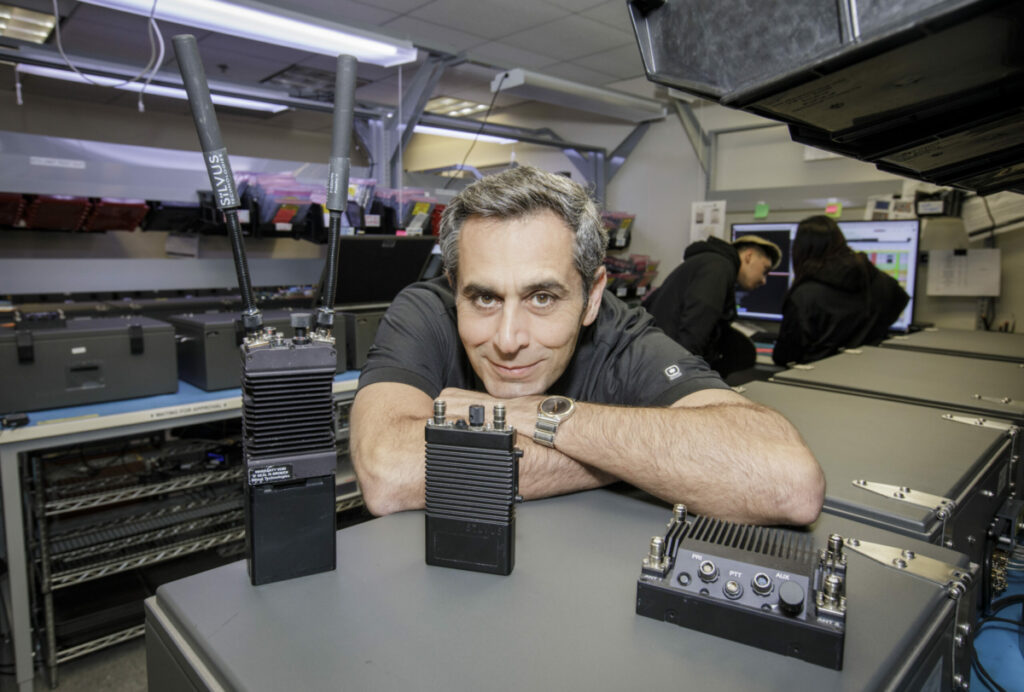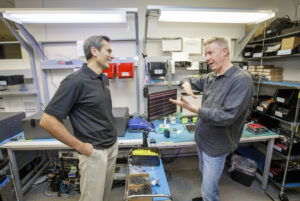Babak Daneshrad refers to his company as a pioneer in wireless technology.
Daneshrad, the chief executive of Silvus Technologies Inc., says that’s because of the company’s development of advanced communications systems used by military forces, law enforcement and first responders.
“That is basically due to our ability to bring cutting-edge technology to the solutions that we provide and integrate it seamlessly with a full understanding of what the customers want – to extend the range, to have something that is reliable and repeatable and gives them the biggest pipe possible,” he said.
Daneshrad, who co-founded Silvus, based in Westwood, with three business partners, said it was built on what’s called Mobile Networked-Multiple Input and Multiple Output technology – or putting multiple antennas on a radio transmitter or receiver.
There was a lot of theoretical work in this area that indicated the technology would be a game changer back in the early days of the company, about 2004, but there was very little in terms of practical applications, he said.
“So we said, hey let’s start looking and see if we can bring this technology that has been shown on the theoretical side to be extremely effective and see if we can bring it to reality and apply it to the mesh network market,” Daneshrad added.
A mesh network connects hundreds of people without any infrastructure. Unlike a cell phone, where one is always talking through a base station, there is no such station in a mesh network. This is particularly useful for the military or some police or fire department situations in which responders rush into a scene and need immediate and massive communication ability.
Mesh networks are also self-healing, meaning they have the ability to continue working if a connection to a node – an electronic device that is attached to the network – is not possible.
Staying networked
The commonality of all the markets that Silvus serves – military and first responders – is that often where they need to operate there is no infrastructure for communications. So, the mesh network helps in keeping them connected.
“That is the only way,” Daneshrad said. “Otherwise, you are in walkie-talkie world where I can only reach the people that are within earshot of my transmitter,”
Last month, the Marine Corps System Command chose Silvus StreamCaster 4400 Manet (which stands for “mobile ad-hoc networking”) radios for use in the networking on-the-move communications system for its joint light tactical vehicles and amphibious combat vehicle.

After a competitive selection process, StreamCaster Manet radios were selected to be a critical piece of the mobile communications architecture based primarily on their ability to create a self-organizing mesh network across multiple spectrum bands at high data rates, according to a release from Silvus.
Chris Nigon, senior director of Navy, Marine, and Air Force Programs at Silvus, said that as the Defense Department increases its use of Manet radios in the joint communications architecture, enabling the Marines’ networking-on-the-move communications system is a significant milestone for the company.
Nigon said the company is proud of “putting high-performance wireless networking capabilities in the hands of our Marines.”
The contract is valued at $5 million.
UCLA connection
Daneshrad was a professor teaching electrical engineering at UCLA when he founded Silvus with his three partners in 2004. He retired from the college in November 2019 to focus on Silvus.
Prior to starting Silvus, he had founded Innovics Wireless, a semiconductor startup that provided technology for cellular mobile networks. He served at the company as chief scientist from January 2001 to August 2003. It was acquired by Roper Technologies in 2005.
A year after leaving Innovics, Daneshrad and his co-founders launched Silvus. The company was initially financed by research and development funding from the Defense Advanced Research Projects Agency, commonly called DARPA, and an Air Force research and development funding organization, among other financing sources.
Daneshrad estimated that the amount of funding from outside sources was “north of $50 million.”
Today, Silvus garners much of its revenue from sales of its StreamCaster radios. Those sales began in late 2011 and brought in about $500,000 in the initial 12-month period. Last year, revenue was $100 million.
“We do some amount of R&D, but the R&D is to develop technology and funnel it into our product,” Daneshrad said.
The company has about 400 customers; some of them are in Europe and Asia, he added. Among them is Anduril Industries, a defense technology company specializing in AI-powered solutions in Orange County. Otherwise, big customers include the Army, Air Force and Marine Corps.
The radios are also used on about 70 different types of drones, many from the military, Daneshrad said.
“Law enforcement is another big market for us, federal law enforcement. And recently we are starting to serve state and local and the first responder markets as well,” he added.
Silvus lets prospective customers use its products at no cost for a trial period, normally offering 10 radios for two weeks.
“They typically will ask for an extension on that time,” Daneshrad said. “They experience the product for themselves and based on that they come back with orders.”
Growth plans
Silvus is a growing company.
It plans to expand its Westwood headquarters from 14,000 square feet to 33,000 square feet. “We can expand the personnel, expand R&D, expand engineering, all of that,” Daneshrad said.
“The market is expanding as well,” he added. “We pride ourselves on being at the forefront of technology, and delivering that technology to the war fighter, to the first responder in the field in an effective and efficient manner.”
Daneshrad said he and his colleagues have heard from its military customers about how they are dealing with near-peer threats – countries that are at par with the United States from a technology and capability standpoint, he continued. So, they have to worry about being covert – using communication signals that are hard to locate and detect – and also about anti-jamming capabilities.
Silvus is at the forefront of the anti-jam product that has been adopted by the Army,
he said.
Called Manet Interference Avoidance, the anti-jam feature senses interference within the network footprint and automatically switches the network to a better channel.
“It is unique in our approach. It is totally different from commercial approaches,” Daneshrad said. “It uses multiple antennas to give really good immunity to jamming and interference without sacrificing your range. We are working on novel techniques on (covert) detection as well.”

Since he has been in business for more than 20 years, Daneshrad said that the lessons he would impart to others thinking of working in Silvus’s sector would come down to a few simple things: being objective, surrounding yourself with smart people, and creating an environment in which the exchange of information and ideas is welcome.
“That’s what I try to do,” he said. “Strive for excellence and don’t let mediocrity creep in.”
